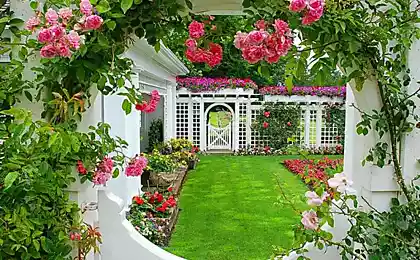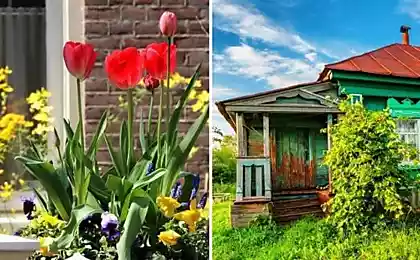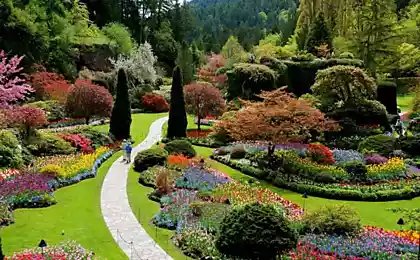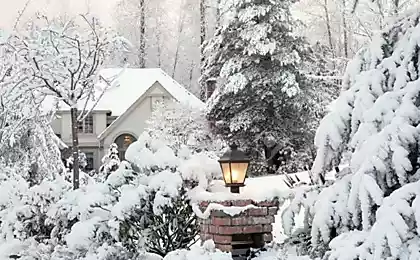569
Hosts: the idea of using the garden
Meet the shy host. It is not astonishing striking beauty, but wins a nice charm. And also represents a huge opportunity to create a stylish garden. About them today and we'll talk.
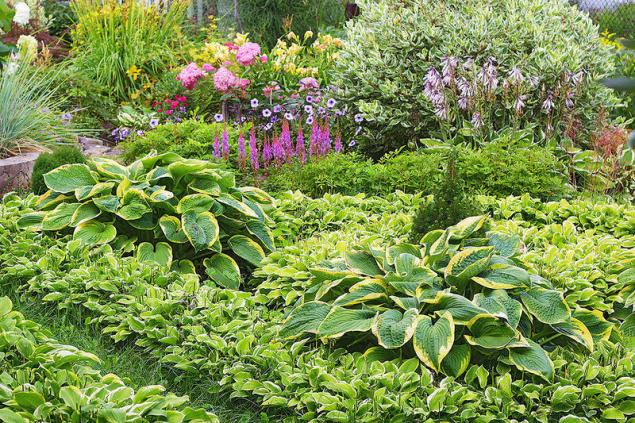
In the shade and in sight
Host — a wand of any gardener. She will readily agree to any kind of soil and will not be fussy about the neighborhood. The only thing that the plant tolerates with difficulty, is direct sunlight, and that if they "roasted" him throughout the day. But in the shady parts of the host feels like a fish in water and blooms well even in such conditions, can boast of very few inhabitants of the garden.

She has another important trump card is diversity. Among the varieties of this plants are dwarfs and giants, characters with bluish foliage, individuals with yellow and original — with a colorful, and even "relatives", painted in various shades of green, do not count.
Leaf form can be very different: from rounded, heart-shaped to narrow, elongated. Varies in size: there are hosts dwarfs, bred specifically for the Alpine hills, and there are real giants.

Tip: host reproduce by rhizomes is much easier and faster than seeds. Watered as the drying of the soil, and periodically feed the plant with fertilizers (at flowering) and organic matter (in the spring) and don't forget to remove faded flowers.
Green "pillow" of the hosts looks great at the foot of the vertical support.

A layered curb — only one of the original ways of using the host in a modern garden.

Hosta 'Sum and Substance' ("BEST") — the most popular variety of light-loving group. The Mature plant is fascinating for its huge size: the height of 80-90 cm, a huge heart-shaped shiny leaves up to 45 cm long and 38 cm wide and the diameter of the shrub to 200 cm.

That capable hosts
These cute girl go perfectly perfectly with all the plants, so desirable in any garden — whether it be the front track or the free area in the landscape style. They are able to create a complimentary background for any group of plants and also perfectly fill the empty space.
Especially good hosts for decorating a variety of water features — ponds, streams and garden fountains. They will fit harmoniously in the landscape of the Japanese garden, making excellent company rhododendron, sedges and ferns.
However, this is a concise plant can play a major role in the garden landscape. Impressive looking single landing host on the lawn, in the entrance area of the garden, the curves of the tracks, near mosinee. In the garden "modules" hosts soloists can be decorated with gravel otsypki that only accentuate their elegance.
Tip: fans of the original songs can complement a host of beautiful driftwood. "Collective" planting these plants can be used as a "live frame" bordering the rest area or in other areas where it is important to emphasize the original shape of the elements or the graceful curve garden paths.
Important: under this option the use of all plants shall be of the same type, size, and shape. Dwarf varieties of the host makes any of the Alpine "venture": the slide, rockeries, a rock garden or rocky composition.
Tall varieties are best to choose for single plantings or the living of the curb for a silky lawn.

Even in the bright flower girl hosts are not lost and will get his share of glory.

Be original
Exquisite use of our prudes in the design of the site is garden host: luxurious composition made without the participation of other plants. Is the winning option for registration of the shady corners of the garden.

To realize such a stylish idea, you need to find hosts of different varieties, colors and forms and drop them off one composition. The main requirement — the more diversity the better!
The plants should vary in shade, shape and size of leaves, and how to combine them together — that is your choice. Options and fantasies — big set: from hosts you can collect "mosaic", to make an asymmetrical composition, or even a kind of "bouquet in a box" — to gather into a single landing hosts a variety of "wrap" them with a border of variegated host.
Heroines of the composition will land as close as possible, with virtually no gaps between them, and the perimeter of such a facility underline gravel dumping or glass, pebbles, wood chips, saw cuts, but not high sides.
Important: a border surrounding the composition, it is necessary to "build" on a certain distance from the plants, given the size of the leaves in a fully expanded state. If the filling is too close, the leaves of the host by the middle of summer will completely cover it.
Tip: if you want to slightly mix things up a bit, the host will put them sedges or grasses. Such sharp contrast would benefit all the neighbors.
Roomy pot — one of the possible "houses" for the hosts, but "to settle" it is better plants are dwarf and compact varieties.
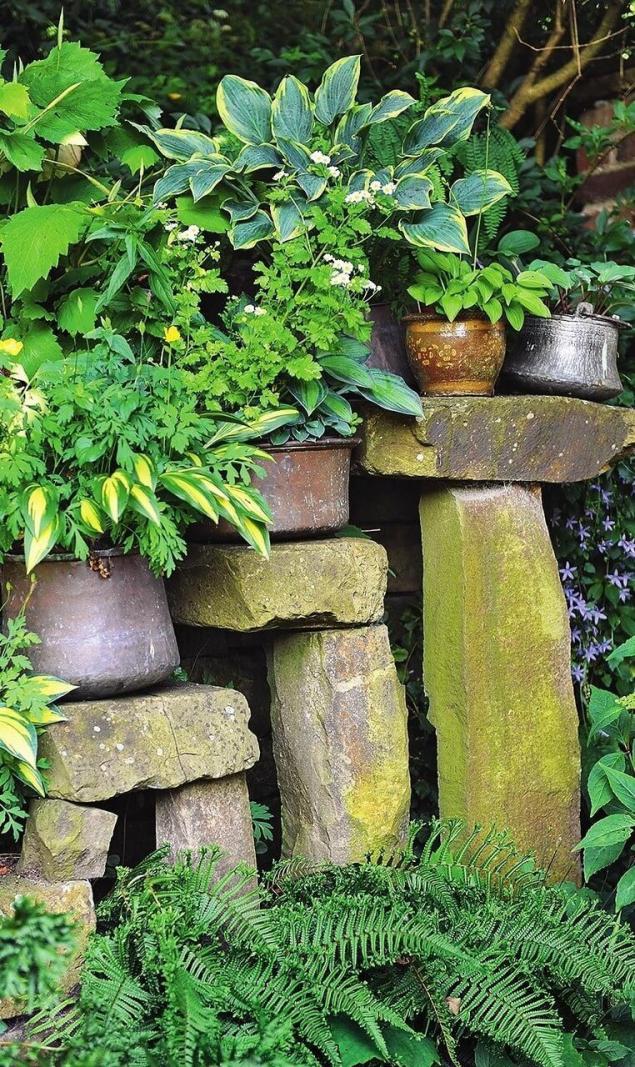
Variegated forms of the plant allow to make surround even the smallest corners of the garden.published

Author: Olga Voronova
Also interesting: Begonia Vale of eternal blossoms in your garden — planting and care Annuals for Your garden, blooming all summer
P. S. And remember, only by changing their consumption — together we change the world! ©
Source: www.7dach.ru/MoySad/hosty-osobennosti-i-idei-ispolzovaniya-v-sadu-21400.html

In the shade and in sight
Host — a wand of any gardener. She will readily agree to any kind of soil and will not be fussy about the neighborhood. The only thing that the plant tolerates with difficulty, is direct sunlight, and that if they "roasted" him throughout the day. But in the shady parts of the host feels like a fish in water and blooms well even in such conditions, can boast of very few inhabitants of the garden.

She has another important trump card is diversity. Among the varieties of this plants are dwarfs and giants, characters with bluish foliage, individuals with yellow and original — with a colorful, and even "relatives", painted in various shades of green, do not count.
Leaf form can be very different: from rounded, heart-shaped to narrow, elongated. Varies in size: there are hosts dwarfs, bred specifically for the Alpine hills, and there are real giants.

Tip: host reproduce by rhizomes is much easier and faster than seeds. Watered as the drying of the soil, and periodically feed the plant with fertilizers (at flowering) and organic matter (in the spring) and don't forget to remove faded flowers.
Green "pillow" of the hosts looks great at the foot of the vertical support.

A layered curb — only one of the original ways of using the host in a modern garden.

Hosta 'Sum and Substance' ("BEST") — the most popular variety of light-loving group. The Mature plant is fascinating for its huge size: the height of 80-90 cm, a huge heart-shaped shiny leaves up to 45 cm long and 38 cm wide and the diameter of the shrub to 200 cm.

That capable hosts
These cute girl go perfectly perfectly with all the plants, so desirable in any garden — whether it be the front track or the free area in the landscape style. They are able to create a complimentary background for any group of plants and also perfectly fill the empty space.
Especially good hosts for decorating a variety of water features — ponds, streams and garden fountains. They will fit harmoniously in the landscape of the Japanese garden, making excellent company rhododendron, sedges and ferns.
However, this is a concise plant can play a major role in the garden landscape. Impressive looking single landing host on the lawn, in the entrance area of the garden, the curves of the tracks, near mosinee. In the garden "modules" hosts soloists can be decorated with gravel otsypki that only accentuate their elegance.
Tip: fans of the original songs can complement a host of beautiful driftwood. "Collective" planting these plants can be used as a "live frame" bordering the rest area or in other areas where it is important to emphasize the original shape of the elements or the graceful curve garden paths.
Important: under this option the use of all plants shall be of the same type, size, and shape. Dwarf varieties of the host makes any of the Alpine "venture": the slide, rockeries, a rock garden or rocky composition.
Tall varieties are best to choose for single plantings or the living of the curb for a silky lawn.

Even in the bright flower girl hosts are not lost and will get his share of glory.

Be original
Exquisite use of our prudes in the design of the site is garden host: luxurious composition made without the participation of other plants. Is the winning option for registration of the shady corners of the garden.

To realize such a stylish idea, you need to find hosts of different varieties, colors and forms and drop them off one composition. The main requirement — the more diversity the better!
The plants should vary in shade, shape and size of leaves, and how to combine them together — that is your choice. Options and fantasies — big set: from hosts you can collect "mosaic", to make an asymmetrical composition, or even a kind of "bouquet in a box" — to gather into a single landing hosts a variety of "wrap" them with a border of variegated host.
Heroines of the composition will land as close as possible, with virtually no gaps between them, and the perimeter of such a facility underline gravel dumping or glass, pebbles, wood chips, saw cuts, but not high sides.
Important: a border surrounding the composition, it is necessary to "build" on a certain distance from the plants, given the size of the leaves in a fully expanded state. If the filling is too close, the leaves of the host by the middle of summer will completely cover it.
Tip: if you want to slightly mix things up a bit, the host will put them sedges or grasses. Such sharp contrast would benefit all the neighbors.
Roomy pot — one of the possible "houses" for the hosts, but "to settle" it is better plants are dwarf and compact varieties.

Variegated forms of the plant allow to make surround even the smallest corners of the garden.published

Author: Olga Voronova
Also interesting: Begonia Vale of eternal blossoms in your garden — planting and care Annuals for Your garden, blooming all summer
P. S. And remember, only by changing their consumption — together we change the world! ©
Source: www.7dach.ru/MoySad/hosty-osobennosti-i-idei-ispolzovaniya-v-sadu-21400.html


